- Submissions

Full Text
Novel Research in Sciences
Averrhoa Bilimbi and its Health Benefits
Jahnavi Priya Gandivalasa* and Janadeepika
Department of Food Nutrition and Dietetics, Andhra University, India
*Corresponding author:Jahnavi Priya Gandivalasa, Department of Food Nutrition and Dietetics, Andhra University, Visakhapatnam- 530003, A.P, India
Submission: October 07, 2024;Published: November 21, 2024
.jpg)
Volume16 Issue 3November 21, 2024
Abstract
Averrhoabilimbi is principally cultivated for medicinal purposes in many tropical and subtropical countries of the world.it is a multipurpose, long-lived tropical plant commonly known as ―Bilimbi, Cucumber Tree belonging to family Oxalidaceae. The plant has an enormous value since most of the parts like flowers, fruits, leaves, bark, seeds, roots or the whole plant are used as alternative medicine to treat a variety of diseases. survey about this plant shows that A. bilimbi is mainly used as a best medicine in the treatment of hypertension, diabetes mellitus and antimicrobial agent. The main objective of this review is to accumulate and organize literatures based on health benefits of A. bilimbi. it holds great value in the complementary and alternative medicine. Hence, this paper presents an overview on covering the biology, and various commercial, therapeutic applications. and comprehensive review on the ethno-medicinal uses, different chemical constituents and pharmacological activities
Keywords:Averrhoabilimbi; Antibacterial activity; Proximate composition; Traditional uses
Introduction
Plants are the main source of drugs that being used from the ancient times as herbal remedies for the health care, prevention and cure of various diseases and ailments. Averrhoa bilimbi L. of family oxalidaceae, widely cultivated throughout tropical countries [1]. for their fruits as these fruits are nutritionally rich. It is commonly called as Bilimbi and medicinally used as a folk remedy for many symptoms. There are many uses in traditional medicine such as fruit conserves or syrups are used for coughs, fevers, and inflammation. Young fruits are waxy shining and green, while mature are yellowish in colour. Fruits are ellipsoid, obovoid or nearly cylindrical, lobed in structure having 4-5 ridges. The size ranges from 5.5 - 7cm long and up to 2-3cm in diameter. On an average 7 seeds are present in a fruit. Flowering in Bilimbi starts around mid-February to late March and fruiting lasts up to late December to early January. Fruit taste is sour. It is widely cultivated in the tropics and its origins are not yet clear.
Nevertheless, Correa (1926) reported that it is native of India, from where it was brought to Brazil centuries ago. In Brazil, this tree is cultivated in the states of Rio de Janeiro, Amazonas, Pará and Santa Catarina, but the distribution of its fruits is limited. In these places, it is locally known as “bilimbi”, “bilimbi no”, “biri-biri”, “caramboleira amarelle” or “limão de caiena”. Bilimbi is a small tree up to 15 meters high. Fruits are fairly cylindrical with five broad rounded longitudinal lobes, and produced in clusters (Figure 1-3). During maturity stage occurs the maximum increase in fruits weight and dimensions, and their external green colour changes into light yellow [2]. Bilimbi fruits are very sour, and used in the production of vinegar, wine, pickles and in the preparation of Hindu dishes. due to high content of oxalic acid, rich in vitamin C, with high level of antioxidants. The vitamin C levels in ripe and half-ripe bilimbi harvested in the same season were statistically different. Ripe fruits harvested during dry season had the highest vitamin C level. This result may have been influenced by climatic factors [1]. As expected, during the dry season, an increase of photosynthetic activity (induced by rising solar radiation and reduced average seasonal rainfall) produces higher levels of vitamin C, since this vitamin is synthesised from hexose sugar precursors. In spite of the low levels of vitamin C in bilimbi, the ripe fruit has significant amount of this vitamin.
Figure 1:Bilimbi flowers.
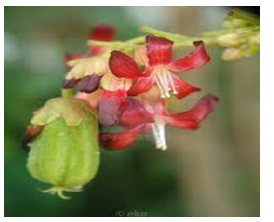
Figure 2:Bilimbi fruit clusters.
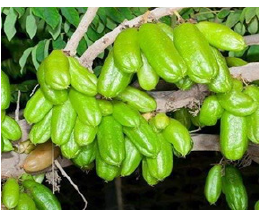
Figure 3:Harvested bilimbi fruits.
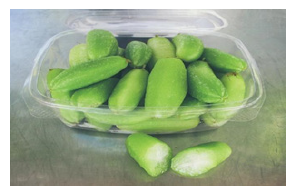
Therefore, the medicinal use of this fruit against scurvy, which was recommended by Correa Averrhoa bilimbi is a potent plant for future research since it has antidiabetic, antihyperlipidemic and antibacterial properties. The fruit has juicy and firm flesh with greenish colour and when its ripe fruit are become soft. Bilimbi fruits are sour in taste and its acidity is very high [3]. Bilimbi is a natural source of Antioxidant, Vitamin B and C and Iron, Phosphorus [4]. Bilimbi fruit has a shorter shelf life due to its juiciness. After they harvest it has shelf life about 4-5 days and rapidly gone waste [5]. Post-harvest losses of bilimbi fruit can be seen. Nevertheless, it can be preserved under certain traditional methods like drying, pickling, jams, jellies…etc.
These are also traditional used, preserved methods of bilimbi in Sri Lanka. The mixture of preservation is used to extend the shelf life of the product. The products can be stored around six months to 1 year in a glass bottle without refrigerating. The product can be added as the sourness enhancer of condiment, like salted lime pickles. As above mentioned, bilimbi is a seasonal crop, therefore consumers can consume bilimbi flavour in off season as well by adding bilimbi pickles, jams, jellies as desired [6].
Origin and Distribution
Perhaps a native of the Moluccas, the bilimbi is cultivated throughout Indonesia; is cultivated and semi-wild everywhere in the Philippines; is much grown in Ceylon and Burma. It is very common in Thailand, Malaya and Singapore; frequent in gardens across the plains of India, and has run wild in all the warmest areas of that country. It is much planted in Zanzibar. Introduced into Queensland about 1896, it was readily adopted and commercially distributed to growers.
Vernacular Names
The bilimbi (Averrhoa bilimbi) is a member of the Oxalidaceae family. It is closely allied to the carambola but quite different in appearance, manner of fruiting flavor and uses. The bilimbi is known locally as “khamrak” or “kornishore” and in other countries known as by the English (cucumber tree, bilimbi, tree sorrel); Filipino (kamias); Spanish (Tiriguro, Pepino De Indias, Mimbro, Grosella China, Vinagrillo); Thai (Naling pring, Taling pling).
Taxonomy
Characteristics of Bilimbi Fruits
Ripe bilimbi fruits have thin skin, yellowish-green color, soft texture and a peculiar smell, which resembles the one of carambola, a fruit of the same botanical family. Half-ripe fruits have firm texture and imperceptible smell.
Effect of drying on physical properties
Higher drying temperatures gives less drying time, a lighter colour but greater product shrinkage, whilst pre-treatment can reduce product shrinkage and drying time and can also give good texture properties (Table 1-5). pre-treatment and the drying temperature are important to improve mass and heat transfer as well as the product characteristics such as colour, shrinkage and texture [7]. Ripe fruits had the highest levels of TSS and vitamin C and lowest levels of oxalic acid, independently of weather conditions. The results showed that maturity stage influenced on physicochemical characteristics of bilimbi fruits [8].
Table 1:
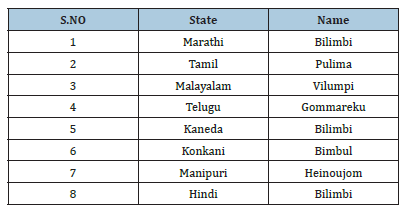
Table 2:Taxonomy.
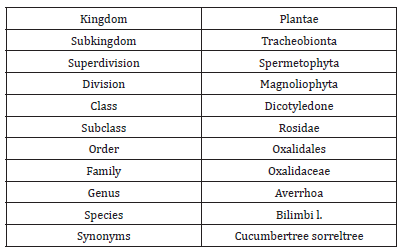
Table 3:Physical Features.
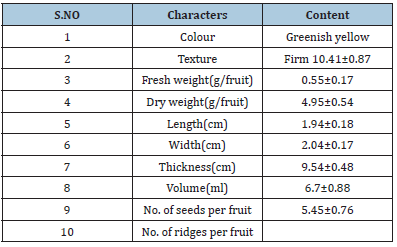
Table 4:Proximate composition of Averrhhoa Bilimbi.
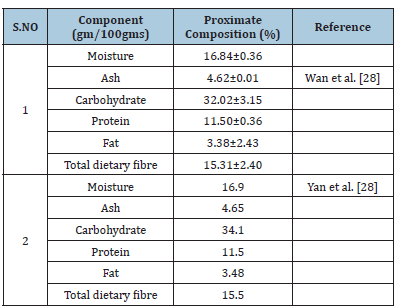
Table 5:Chemical characteristics in ripe and half ripe bilimbi fruits harvested on dry and rainy season.

Phytochemical constituents
The extract of various parts of Averrhoa bilimbi is medicinally used as a folk remedy for many symptoms and showed significant pharmacological activities so it is necessary to perform further investigation to isolate such pharmacological active compounds which can be used in production of novel drugs for various diseases [9].
Toxic effect
This fruit contents high level of oxalate. Acute renal failure due to tubular necrosis caused by oxalate crystal has been noted. bilimbi fruit juice should be avoided in CKD and on dialysis patients [10]. Averrhoa bilimbi species, and exhibits similar biochemical characteristics to star fruit [11]. Freshly made concentrated juice has a very high oxalic acid content and consumption carries a high risk of developing Acute Renal Failure (ARF) by deposition of Calcium Oxalate crystals in Renal Tubules. Acute Oxalate Nephropathy (AON) due to secondary oxalosis after consumption of Irumban Puli Juice is uncommon [12]. Oxalic acid has been identified as the principal acid in the carambola (Averrhoa carambola L.) and the bilimbi (A. bilimbi L.) (2). While quantitative levels have been reported for carambola, oxalic acid has only been reported qualitatively for bilimbi. The habitual use of fruits with high oxalic acid levels could lead to the ingestion of levels that may result in significant nutrient-toxicant interactions in the Guyanese population [13]. Bilimbi fruit extract shows the protective effect to the histological structure damage of mices renal cells induced by reheated palm oil. The increasing of dose of the Bilimbi fruit extract improves the protective effect to mices renal cells [14]. The combination of doxorubicin with BM-extract significantly increased the mean survival time (MST) in EAC-mice. BM-extract treatment modulated the antioxidants both in heart and liver tissues of EAC-mice. For mechanistic approach, BM-extract showed in vitro antioxidant activity (measured by DPPH and FRAP assay) and inhibited intracellular generation of ROS and nitrite in RAW264.7 cells.
Conclusion: The protection from doxorubicin-induced cardiotoxicity by BM-extract was attributed to its antioxidant activity and inhibition of intracellular free radical generation [15].
Vitamins and mineral analysis
Averrhoa bilimbi L. (Oxalidaceae) is widely distributed and cultivated throughout tropical countries for its fruits. Parts such as Leaves, Bark, Fruits are widely used in medicine as a folk remedy for many symptoms. fruit is good source of minerals such as Potassium, Phosphorus, Nitrogen, Calcium, Magnesium and Iron suggesting its use as a potential [16]. Vitamins are crucial to all life functions. Vitamins are also called as co-enzymes because they work with enzyme and enable them to trigger all body processes. Among the vitamins, the Vitamin C is an important vital amine to maintain the body in good health. The main sources of Vitamin C are from fresh fruits and vegetables. The fruit juice contains Vitamin C and in addition to that it contains glucose and protein. The nutritive contents were estimated. The Antibacterial activity of above two plants fruit juice were carried out in order to ascertain the disease resistance property [17]. Raw bilimbi fruit at the harvesting stage (yellowish green) was autoclaved for 3 hours at 121 °C, 15psi and analysed for ash, vitamin C, titratable acidity, pH and colour. Autoclaved bilimbi fruit contains 0.65% ash which was significantly (p<0.05) higher than the raw bilimbi (0.50%). pH slightly increased (2.78) after autoclaving. Vitamin C content (12mg/100g) and titratable acidity which was reported as oxalic acid (0.34mg/100g) were lower in the autoclaved fruits and the fruits were darker based on the ‘L’ value (42.63). Thus, autoclaving affects some of the physicochemical properties of the bilimbi fruits [18].
Anti-bacterial effect
The antimicrobial activity was highest for the fruit extract against the Gram-negative Salmonella paratyphi (23.0 ± 0.50mm) and the Grampositive Bacillus megaterium (19.0 ± 0.40mm) bacteria, somewhat weaker against the Staphylococcus aureus, Bacillus subtilis, while with the leaf extract poor activity was observed against all 12 bacteria [19]. Ethanol extract showed scavenging property against DPPH (82.82mg GAE/ g DW) and gave a more inhibitory effect on the growth of Salmonella sp., Escherichia coli, and Staphylococcus aureus. The phenolic compounds might be associated with the antioxidant and antibacterial activities of this extract [20].
Anti diabetic effect
The phyto constituents like flavonoids, saponins and triterpenoids have been isolated from Averrhoa bilimbi increased glucose uptake and glycogen storage in-vitro rat hemi diaphragm technique proved that Averrhoa bilimbi is having the wide anti diabetic activity [21]. Averrhoa bilimbi Linn. (Oxalidaceae) is a medicinal plant and is reported to possess hypoglycemic activity [22]. Hyperglycemia-mediated oxidative stress plays a major role in the development of diabetic complications. Averrhoa bilimbi Linn. (Oxalidaceae) is a medicinal plant with fruits reported to possess antidiabetic activity. bilimbi fruits at a dose of 25mg/kg body weight for 60 days. Serum Glucose, Glycated Hemoglobin, Plasma Insulin, Hepatic Toxicity markers, Antioxidant Enzymes, Lipid Peroxidation products, and liver histopathology were assayed checked after 60 days of extract treatment. Diabetic rats administered ABAEE showed a significant decline in Serum Glucose, Glycated Hemoglobin, and also significantly increases the level of plasma insulin, as well as a notable attenuation in thiobarbituric acid-reactive substances, conjugated dienes, and hydroperoxides. ABAEE also modulated hepatic antioxidant potential by significantly increasing the activities of catalase, glutathione peroxidase, glutathione reductase, superoxide dismutase, and reducing glutathione content [23].
Antimicrobial properities
The extracts have stronger antimicrobial effects against Gram negative bacteria, Salmonella spp. with inhibition zone of 12mm at young fruit, 11mm at mature fruit and 9.3mm at ripe fruit than Escherichia coli and Pseudomonas aeruginosa. The antimicrobial properties are influenced by the maturity stages of the fruit especially at early stage of maturity [24]. A. bilimbi fruit has been used as traditional remedies to cure fever, coughs, inflammation, diabetes and hypertension Concentration of 1000μg/ml of the extracts were diffused into blank filter paper disc and placed onto cultured agar. The preliminary screening for both extracts showed inhibition activity against all tested bacteria. The Minimum Inhibitory Concentration (MIC) was performed by using microdilution broth method. The MIC value of aqueous extract are the same for all organism tested which is 62.5μg/ml. The MIC value of ethanol extract is 62.5μg/ml for S. aureus, E. coli and S. typhimurium while B. cereus showed slightly lower MIC value which is 31.25μg/ml. The Minimum Inhibitory Concentration (MBC) was done to confirm the MIC value. All tested organism showed the same MBC value when treated with aqueous extract which is 125μg/ml. The MBC value of ethanol extract is 125μg/ml for S. aureus, E. coli and S. typhimurium while B. cereus showed lower MIC value which is 62.5μg/ml [25].
Anticoagulant activity
The high level of oxalic acid in A. bilimbi, which range from 10.5 to 14.7mg/g in green, unriped fruit and 8.45 to 10.8mg/g in ripe fruit could provide the anticoagulation effect [26].
Anti Inflammatory effect
The treatment with Averrhoa bilimbi L. fruit extract has shown a significant antioxidant activity in the UC condition by reducing the levels of NO and enhancing the levels of SOD and GSH in the colon tissue [27].
Antioxidant capacity
Total phenolic content was higher in carambola although bilimbi yielded more total flavonoid. Vitamins A, C, and E contents of bilimbi were also higher than carambola [28]. A. bilimbi fruit extract showed strong cytotoxic potential with an LC50 value of 5.011μg/ml in brine shrimp lethality bioassay. Our results suggest that, in addition to having cytotoxic potential, A. bilimbi fruits are rich in polyphenolic antioxidants with strong radical scavenging capacity [29]. The extract of Bilimbi fruit decrease SGPT level in mice induced by reheated palm oil [30].
Anticancer activity
The methanolic fruit extract exhibited significant cytotoxic potential against MCF-7 human breast cancer cell lines with an IC50 value of 154.9μg/ ml whereas an IC50 value of 668μg/ml observed for ethanolic leaf extract. The methanolic fruit extract could be considered as a source of novel anticancer compounds [31].
Anti-allergic activity
The anti-allergy effect of Averrhoa bilimbi Linn. fruit water extract (AFWE) was examined using RBL- 2H3 cells. At first, the cytotoxicity effect of AFWE was determined by WST-8 assay. The release of β- hexosaminidase by RBL-2H3 cells was also measured to evaluate degranulation suppression activity of AFWE. Lastly, calcium assay was employed to investigate the intracellular calcium concentration ([Ca•2+]i). [32].
Ethnomedicinal Uses
A. bilimbi is mainly used as a folk medicine in the treatment of diabetes mellitus, hypertension, and as an antimicrobial agent. Several pharmacological studies have demonstrated the ability of this plant to act as Antidiabetic, Antihypertensive, Thrombolytic, Antimicrobial, Antioxidant, Hepatoprotective, and Hypolipidemic agent. A. bilimbi holds great value in the complementary and alternative medicine as evidenced by the substantial amount of research on it [33].
Value Added Products
Ingredients and tools in making the Bilimbi Fruit (Averrhoabilimbi) Juice were minimal, less expensive, and were available in the locale market. Shelf life ranged for 1 to 7 days at room temperature. All treatments of “Bilimbi Fruit” Averrhoabilimbi Juice was liked by the respondents in all four attributes. Generally [34]. Bilimbi fruit, locally known in the Philippines as kamias in Tagalog/Filipino (National Language of the Philippines) and Iba in Waray -waray (Local dialect of Guiuan, Eastern Samar) is good to be used as flavoring for candy [35]. Bilimbi (Averrhoa bilimbi L.) is long lived underutilized perennial evergreen plant particularly cultivated in home gardens, belong to the family of oxalidaceae. Bilimbi pickle was prepared using bilimbi fruits and other ingredients of salt, cinnamon, cardamom, cloves, and black pepper. Formulations and procedures were created prior to prepare the product. Well matured fruits were selected and prepared product was filled into glass bottles and stored at room temperature for a week and evaluated color, aroma, and taste at an interval of one day. The product preserves by osmotic dehydration, in use of salt, by natural acidic environment within bottle, by antimicrobial and antioxidant properties due to added spices and heat and sun drying treatments as well [36].
The bilimbi can be introduced as the food flavoring as it contains high in acid and can act as souring agent. Approximately 3g of pectin should meet the sensory acceptability requirements in terms of the texture of the jam. Bilimbi fruit can be used to make a fruit jam with good sensory acceptability which suggests high market potential due to TPC that can contribute to antioxidant activity [37].
Scavenging Activity
Averrhoa bilimbi L. belongs to family Oxalidaceae. Traditionally, people use this plant (root, bark, leaves and fruits) for treating several illnesses include itches, boils, syphilis, whooping cough, hypertension, fever and inflammation. fruit extract is a rich source of phytochemicals (natural products) with biological activity. The GC–MS report on this fruit proves that natural products have pharmacologically and biologically active compounds [38]. The phytochemical screening revealed the potent source of different phytochemical constituents on different extractives including, phenol, flavonoid, tannin that are responsible for antioxidant action. In the determination of total phenolic content, different extractives showed a significant content of phenolic compounds ranging from 50.23-68.67mg of GAE/g of extractive. The plant sample displayed significant DPPH free radical scavenging activity with highest IC50 value in crude methanolic extract (30.365?g/ml) followed by chloroform, carbon tetrachloride, pet-ether and aqueous soluble fractions having value of 32.852 ?g/ml, 36.708 ?g/ml, 50.35 ?g/ml, and 79.918?g/ml, respectively as opposed to that of the scavenging effects of BHT of 19.656 ?g/ml [39].
Hptlc Fingerprint
The fruits of Averrhoa bilmbi L. are used to treat skin disorders, fever, for scurvy and beneficial in diarrhoea, hepatitis and in inflammatory condition. It is also used to treat hyperlipidaemia and possess potential antibacterial and antioxidant activity. Pharmacognostical evaluation included examination of morphological and microscopical characters, physicochemical properties, phytochemical analysis, fluorescence study and HPTLC fingerprint. The powder microscopy showed the presence of simple and glandular trichomes and spiral thickening of vessels. Phytochemical screening reported the presence of carbohydrates, proteins, amino acids, flavonoids, tannins and hydrolysable tannins. The HPTLC fingerprint developed for the separation of phytoconstituents is unique to A. bilimbi L. fruit powder. HPTLC fingerprint has been developed; as the chemical fingerprint obtained by chromatographic techniques are strongly recommended for the purpose of quality control of herbal medicines. This unique band pattern obtained from HPTLC fingerprint can be used for the identification of A. bilimbi L. fruits [40].
Umami Compounds
Salted fermented fruit known as asam sunti (Averrhoa bilimbi L.) in Indonesia has been used as a source of umami taste. Organic acid as well as amino acid seemed to play an important role in the intense umami taste of asam sunti [41].
Conclusion
A. bilimbi is an important medicinal plant used in traditional medicine for the treatment of various ailments and in maintaining good health and well-being. A. bilimbi’s leaves and fruits in the treatment of several diseases including diabetes mellitus, hypertension and microbial infections. Plants are the major source for bio-active compounds they are meant for several biological activities in human and animals. As the prevalence of obesity and Diabetes mellitus are very common in our society, research on plants with antidiabetic and antibacterial properties as evidenced by the current research on the various plant parts [42-44].
References
- Berkly F (2016) Fermentation of bilimbi (Averrhoa bilimbi L.) wines: Physicochemical and sensory characteristics, pp. 1-50.
- Mathew L, George ST, Babylatha AK, Geetha CL (1993) Flowering and fruit development in bilimbi (Averthoa bilimbi L.). South Indian Horticulture 41: 41-41.
- Abraham CM (2016) Antibacterial effects of Averrhoa bilimbi L. fruit extracts. Int Res J Biological Sci 5(8): 72-74.
- Alhassan AM, Ahmed QU (2016) Averrhoa bilimbi Linn: A Review of its ethnomedicinal uses, phytochemistry, and pharmacology. Journal of Pharmacy & Bioallied Sciences 8(4): 265-271.
- Kumar KA, Gousia SK, Anupama M, Latha JNL (2013) A review on phytochemical constituents and biological assays of Averrhoa bilimbi. Int J Pharm Pharm Sci Res 3(4): 136-139.
- Gunawardhana ER, Weerasooriya RM, Jayasinghe T, Konara LN (2020) Preparation and Quality Evaluation of Bilimbi Pickle.
- Shahari N, Nursabrina M, Suhairah AZ (2015) The effects of drying on physical properties of bilimbi slices (Averrhoa bilimbi L.). In AIP Conference Proceedings. AIP Publishing LLC 1660(1): 070075.
- Lima VLAGD, Mélo Eda, Santos Lima Ld (2001) Physicochemical characteristics of bilimbi (Averrhoa bilimbi ). Revista Brasileira de Fruticultura 23(2): 421-423.
- Kumar KA, Gousia SK, Anupama M, Latha JNL (2013) A review on phytochemical constituents and biological assays of Averrhoa bilimbi. Int J Pharm Pharm Sci Res 3(4): 136-139.
- Miah OF, Hossain RM, Ahammod T, Dowel FA (2018) Acute Oxalate Nephropathy due to "Averrhoa Bilimbi": A Case Report. Mymensingh Medical Journal MMJ 27(3): 650-653.
- Caetano CP, de Sá CB, Faleiros BAP, Gomes MFCF, Pereira ERS (2017) Neurotoxicity following the ingestion of Bilimbi fruit (Averrhoa bilimbi) in an end-stage renal disease patient on hemodialysis. Case Reports in Nephrology and Dialysis 7(1): 6-12.
- Bakul G, Unni VN, Seethaleksmy NV, Mathew A, Rajesh R, et al. (2013) Acute oxalate nephropathy due to ‘Averrhoa bilimbi’ fruit juice ingestion. Indian J Nephrology 23(4): 297-300.
- Joseph J, Mendonca G (1989) Oxalic acid levels in Averrhoa Carambola L and Averrhoa bilimbi L. In Proc Interam Soc Trop Hortic 33:
- Edoryansyah PA, Wijayanti L (2016) Effect of Bilimbi Fruit Extract (Averrhoa bilimbi L.) on renal histological structure in mice induced by reheated palm oil exposure. Nexus Biomedika 5(2):
- Francis A, Nayak Y (2017) Modulation of Doxorubicin-Induced Cardiotoxicity by Averrhoa bilimbi J Young Pharm 9(1): 69-77.
- Dangat BT, Shinde AA, Jagtap DN, Desai VR, Shinde PB, et al. (2014) Mineral analysis of Averrhoa bilimbi L. A potential fruit. Asian J Pharm Clin Res 7(3): 150-151.
- Ariharan VN, Kalirajan K, Meena Devi VN, Prasad NP (2012) An exotic fruit which forms the new natural source for vitamin-C. RASAYAN J Chem 5: 356-359.
- Ismail N, Aminudin EH (2018) Physicochemical properties of raw and autoclaved bilimbi (Averrhoa bilimbi L.). CCE 2018 and Biological Sciences 3(3): 924-928.
- Das SC, Sultana S, Roy S, Hasan SS (2011) Antibacterial and cytotoxic activities of methanolic extracts of leaf and fruit parts of the plant Averrhoa bilimbi (Oxalidaceae). American Journal of Scientific and Industrial Research 2(4): 531-536.
- Iwansyah AC, Desnilasari D, Agustina W, Pramesti D, Indriati A (2021) Evaluation on the physicochemical properties and mineral contents of Averrhoa Bilimbi L. leaves dried extract and its antioxidant and antibacterial capacities. Food Science and Technology (AHEAD) 41(4): 987-992.
- Shetty P, D’Souza U P, Shama P, James M (2011) In vitro Anti-diabetic activity of Averrhoa Bilimbi Fruit Extract.
- Kurup SB, Mini S (2017) Protective potential of Averrhoa bilimbi fruits in ameliorating the hepatic key enzymes in streptozotocin-induced diabetic rats. Biomed & Pharmacother 85: 725-732.
- Kurup SB, Mini S (2017) Averrhoa bilimbi fruits attenuate hyperglycemia- mediated oxidative stress in streptozotocin-induced diabetic rats. J Food Drug Anal 25(2): 360-368.
- Mokhtar SI, Aziz NAA (2016) Antimicribial Properities of Averrhoa bilimbi Extracts at different Maturity Stages. J Med Microb Diagn 5(3): 1-3.
- Abd Azhar H (2016) Antimicrobial activity of Averrhoa bilimbi fruit extracts against foodborne bacteria/by Hazirah bt Abd Azhar (Doctoral dissertation, Universiti teknologi MARA, Puncak Alam Campus).
- Daud N, Hashim H, Samsulrizal N (2013) Anticoagulant activity of Averrhoa bilimbi Linn in normal and alloxan-induced diabetic rats. In The Open Conference Proceedings Journal 4(1): 21-26.
- Suluvoy JK, Sakthivel KM, Guruvayoorappan C, Grace VB (2017) Protective effect of Averrhoa bilimbi L. fruit extract on ulcerative colitis in wistar rats via regulation of inflammatory mediators and cytokines. Biomed & Pharmacother 91: 1113-1112.
- Yan SW, Ramasamy R, Alitheen NBM, Rahmat A (2013) A comparative assessment of nutritional composition, total phenolic, total flavonoid, antioxidant capacity, and antioxidant vitamins of two types of Malaysian underutilized fruits (Averrhoa bilimbi and Averrhoa carambola). International Journal of Food Properties 16(6): 1231-1244.
- Chowdhury SS, Uddin GM, Mumtahana N, Hossain M, Hasan SR (2012) In-vitro antioxidant and cytotoxic potential of hydromethanolic extract of Averrhoa bilimbi L. International Journal of Pharmaceutical Sciences and Research 3(7): 226.
- Mulyono RD, Putranto RPA (2016) Antioxidant Effect of Bilimbi Fruit (Averrhoa Bilimbi Linn) Extract on SGPT Level in Mice Induced by Reheated Palm Oil. Nexus Kedokteran Translasional 5(2):
- Nair MS, Soren K, Singh V, Boro B (2016) Anticancer activity of fruit and leaf extracts of Averrhoa bilimbi on mcf-7 human breast cancer cell lines: A preliminary study. Austin J Pharmacol Ther 4(2): 1082.
- Santoso WH, Ishida M, Nishi K, Sugahara T, Putra ABN (2021) Anti- Allergy Potential of Averrhoa bilimbi Linn. Fruit water extract shown by its suppressive effect on the degranulation of RBL-2H3 Cells. Journal of Functional Food and Nutraceutical 2(2): 81-88.
- Alhassan AM, Ahmed QU (2016) Averrhoa bilimbi Linn.: A Review of its ethnomedicinal uses, phytochemistry, and pharmacology. J Pharm Bioallied Sci 8(4): 265.
- Astillo JD (2020) Bilimbi Fruit (Averrhoabilimbi) Juice. International Journal of Environment, Agriculture and Biotechnology 5(3): 610-615.
- Gaytos CEG, Abalorio J, Lavilla I, Abalorio L (2019) Acceptability of Bilimbi (Averrhoa Bilimbi) Candy. p. 32.
- Gunawardhana ER, Weerasooriya RM, Jayasinghe T, Konara LN (2020) Preparation and Quality Evaluation of Bilimbi Pickle. Journal of Research Technology and Engineering 1(3): 38-49.
- Anuar NA, Salleh RM (2019) Development of fruit jam from Averrhoa bilimbi L. Journal of Food Processing and Preservation 43(4): e13904.
- Suluvoy JK, Grace VB (2017) Phytochemical profile and free radical Nitric Oxide (NO) scavenging activity of Averrhoa bilimbi L. fruit extract. 3 Biotech 7(1): 85.
- Hasanuzzaman M, Ali MR, Hossain M, Kuri S, Islam MS (2013) Evaluation of total phenolic content, free radical scavenging activity and phytochemical screening of different extracts of Averrhoa bilimbi (fruits). International Current Pharmaceutical Journal 2(4): 92-96.
- Patil AG, Koli SP, Patil DA (2013) Pharmcognostical standardization and HPTLC fingerprint of Averrhoa bilimbi (L.) Journal of Pharmacy Research 6(1): 145-150.
- Istiqamah A, Lioe HN, Adawiyah DR (2019) Umami compounds present in low molecular umami fractions of asam sunti–A fermented fruit of Averrhoa bilimbi L. Food chemistry 270: 338-343.
- Soumya SL, Nair BR (2016) Assessment of heavy metals in Averrhoa bilimbi and A. Carambola fruit samples at two developmental stages. Environmental monitoring and assessment 188(5): 291.
- Lisha V, John P, Sujith S, Usha PTA (2019) Effect of Averrhoa bilimbi fruit powder on Histopathology and the Functional Indices of the Liver and Kidney of Rats fed with high fat diet. The Pharma Innovation Journal 8(1): 48-51.
- Shafie MH, Yusof R, Gan CY (2019) Deep Eutectic Solvents (DES) mediated extraction of pectin from Averrhoa bilimbi: Optimization and characterization studies. Carbohydrate Polymers 216: 303-311.
© 2024 Jahnavi Priya Gandivalasa. This is an open access article distributed under the terms of the Creative Commons Attribution License , which permits unrestricted use, distribution, and build upon your work non-commercially.
 a Creative Commons Attribution 4.0 International License. Based on a work at www.crimsonpublishers.com.
Best viewed in
a Creative Commons Attribution 4.0 International License. Based on a work at www.crimsonpublishers.com.
Best viewed in 







.jpg)






























 Editorial Board Registrations
Editorial Board Registrations Submit your Article
Submit your Article Refer a Friend
Refer a Friend Advertise With Us
Advertise With Us
.jpg)






.jpg)














.bmp)
.jpg)
.png)
.jpg)










.jpg)






.png)

.png)



.png)






